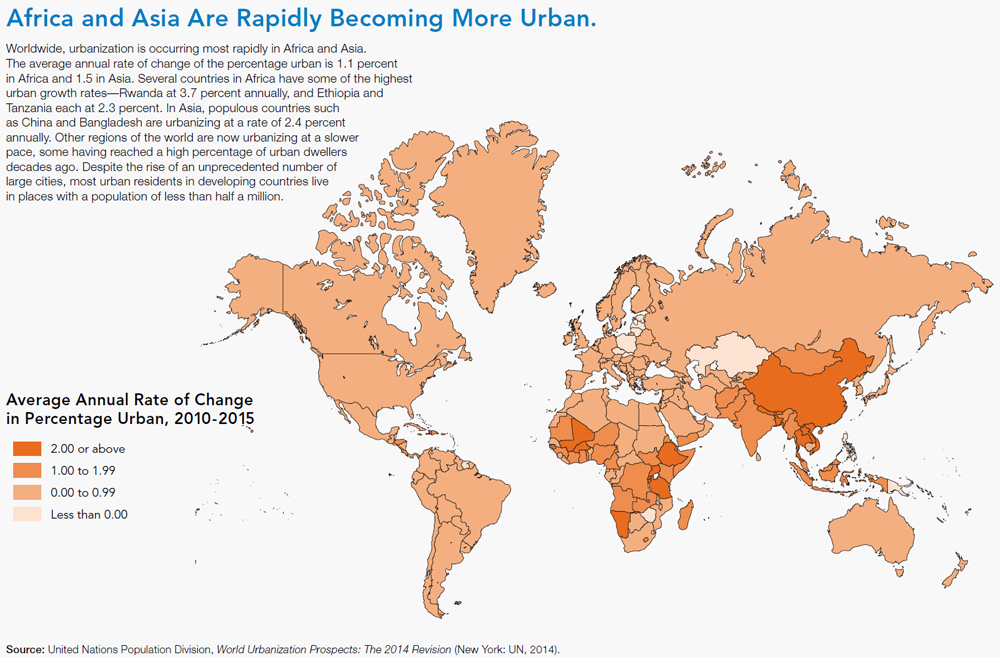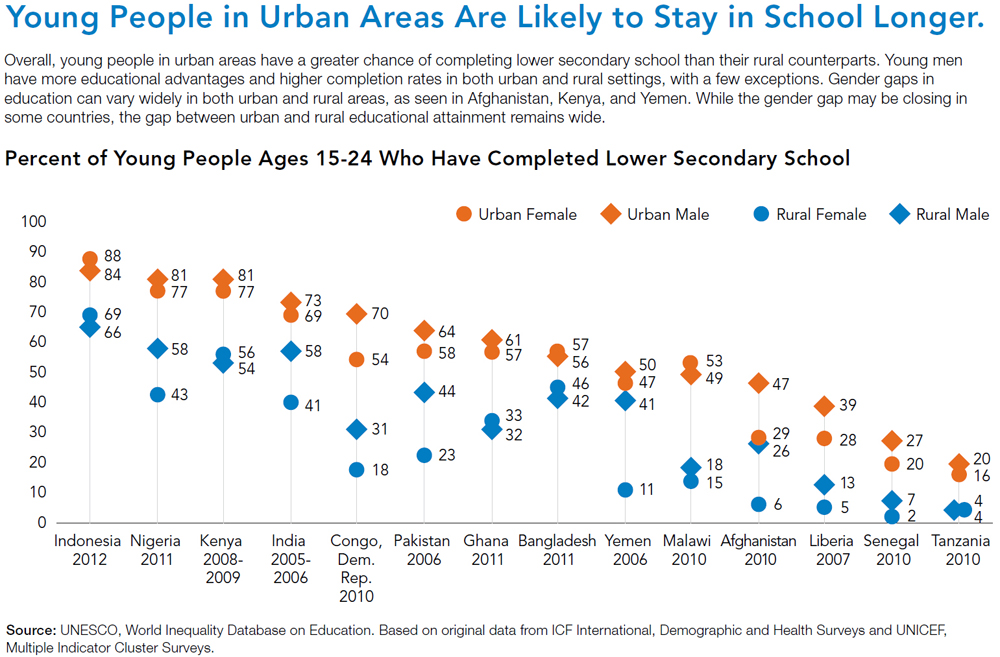-
As African Cities Grow, Rural-Urban Divides Widen Too
July 22, 2015 By Josh Feng
In 2007, the world crossed a threshold: for the first time in human history, the majority of people lived in urban areas. Today, Africa and Asia are the only remaining continents where the rural population outnumbers urban, but they are urbanizing at unprecedented rates. This rapid growth is a double-edged sword. While urbanization spurs economic opportunity and often increases access to infrastructure, it is also widening disparities in health and development, according to a new data sheet by the Population Reference Bureau.
Africa is not expected to be majority urban for at least 20 yearsAccording to data collected by the United Nations Department of Economic and Social Affairs between 2010 and 2015, Rwanda has the highest average annual rate of change in its urban population at 3.69 percent per year, an increase of more than 1.3 million people over the five year period. Burkina Faso comes third after Laos with a 3.03 percent change per year. Despite this rapid growth, both African countries remain largely rural – only 28 percent of Rwandans and 29 percent of Burkinabés live in urban areas.
These numbers are indicative of larger trends. While Asia’s urban population is projected to surpass its rural population within five years, Africa is not expected to be majority urban for at least another 20 years.
The agricultural sector remains the dominant livelihood for many in sub-Saharan Africa. In Rwanda, 79 percent of the population relies on agriculture; in Burkina Faso it is 85 percent. With so many people dependent on farming, environmental changes and population growth are compounding other pressure points. For instance, in Burkina Faso where agricultural production is primarily done by women, intense droughts linked to climate change are not only affecting food security, but women’s health as well.
The datasheet shows other gender divides amidst the urban-rural dichotomy. Young people in urban areas of developing countries are generally likely to stay in school longer than their rural counterparts, and young men (ages 15 to 24) are more likely to have completed lower secondary school than women. Overall, rural women and girls are least likely to complete schooling. But in Malawi, the gender disparity in educational attainment actually flips, as more urban women than men are likely to have completed school.
Urbanization can bring progress, but not necessarily for everyone. Mali has a relatively high rate of urbanization at 2.07 percent per year, and modern contraceptive use has risen steadily since 1987. However, a pronounced urban-rural divide is forming, as urban, married Malian women are using modern contraceptives at a rate over three times that of their rural counterparts. Even if rural contraceptive use catches up to urban rates, Mali will still be at half the level of use compared to Zambia and Rwanda, where the urban and rural levels are relatively equal.
Likewise in Ethiopia, which is also urbanizing rapidly, rural fertility rates are almost double (5.5 children per woman) that of urban areas (2.6, the second lowest in sub-Saharan Africa). Even more drastic, 50 percent of urban residents receive skilled attendance at delivery, whereas only four percent of the rural population does.
As explored in ECSP’s latest documentary, Paving the Way: Ethiopia’s Youth on the Road to Sustainability, innovative efforts are underway to reach Ethiopia’s rural regions with health care and environmental training to reduce degradation and preserve natural resources. While these projects are creating tangible impacts, it’s clear they are needed at a much greater scale to close rural-urban divides in other areas.
Sources: Population Reference Bureau, UN News Center, United Nations Department of Economic and Social Affairs, United Nations Environment Program.
Photo Credit: Table Mountain in Cape Town, South Africa, courtesy of flickr user Damien du Toit. Images: Population Reference Bureau.
 A Publication of the Stimson Center.
A Publication of the Stimson Center.





